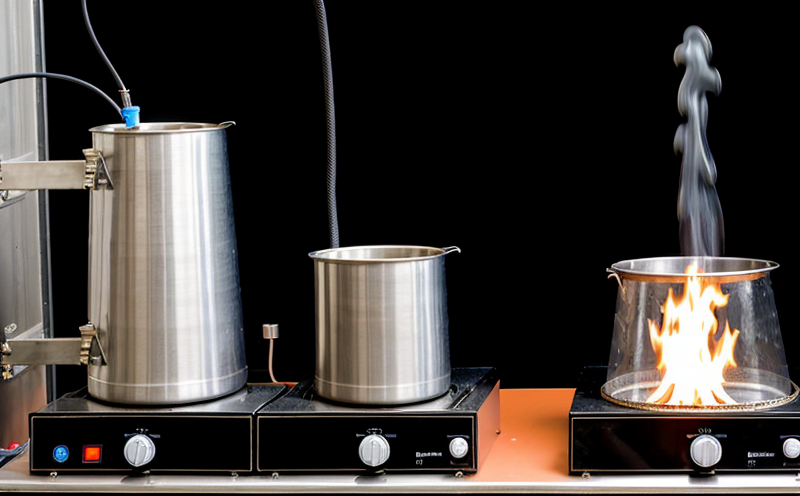Heat Release Testing of Upholstery Materials
The testing of upholstery materials under heat release conditions is a critical component in ensuring fire safety and compliance with international standards. This service involves subjecting upholstered materials to controlled combustion environments, measuring the rate at which they release heat, smoke, and other products of combustion. Such tests are essential for assessing the flammability characteristics of textiles used in furniture, automotive interiors, and other soft furnishings.
Understanding the thermal stability of upholstery materials is paramount when designing fire-safe products. The test method typically involves placing a standard sample on a calorimeter where it is exposed to an ignition source. During this process, instruments measure various parameters including heat release rate (HRR), mass loss rate, and smoke production rate.
The primary goal of these tests is to evaluate the material's ability to withstand fire hazards without causing excessive smoke or heat that could pose a risk to human life. The results help manufacturers make informed decisions about selecting appropriate materials and designs for their products, thereby ensuring compliance with safety regulations.
One of the key challenges in conducting this type of testing lies in accurately simulating real-world conditions while maintaining consistency across multiple samples. To achieve reliable data, it's crucial to follow strict protocols regarding sample preparation and handling. For instance, pre-treatment steps like washing or conditioning can significantly affect test outcomes.
In addition to the mechanical properties often associated with textiles, understanding how materials behave during combustion is equally important. This includes knowing not only their ignition temperatures but also their flame spread rates once ignited. By providing detailed reports based on these measurements, our laboratory offers valuable insights into material performance under various scenarios.
Our state-of-the-art facilities allow us to perform comprehensive evaluations using advanced calorimetric equipment capable of capturing nuanced details about the combustion behavior of upholstery materials. With this capability comes a deep understanding of relevant standards such as those outlined in ISO 13565-2 and ASTM E648.
For manufacturers seeking peace of mind regarding their product's fire safety, our service provides assurance that they are meeting current regulatory requirements while also contributing to broader efforts towards safer environments. Through rigorous testing procedures combined with expert analysis, we ensure customers receive accurate information they can rely upon when making important decisions about material selection.
Industry Applications
| Application Area | Description |
|---|---|
| Furniture Manufacturing | Evaluating the flammability characteristics of fabrics used in sofas, chairs, and other seating furniture. |
| Automotive Interior Design | Assessing the safety of materials utilized within vehicles to prevent fires starting or spreading rapidly. |
| Hotel & Hospitality Industry | Ensuring guest rooms are equipped with safe and non-toxic furnishings that meet strict fire safety standards. |
| Contract Furniture Suppliers | Verifying the compliance of commercial-grade seating solutions against applicable regulations. |
| Residential Fire Safety Programs | Supporting initiatives aimed at reducing household risks through improved material choices and construction practices. |
The data obtained from heat release testing plays a pivotal role in these diverse applications, helping stakeholders across industries ensure their products meet stringent safety criteria. Whether it's for developing new designs or validating existing ones, our laboratory offers unparalleled expertise and precision in providing accurate test results.
International Acceptance and Recognition
The importance of international acceptance cannot be overstated when discussing heat release testing for upholstery materials. Many countries have adopted specific standards to regulate the production and use of fire-resistant textiles, recognizing their critical role in reducing fatalities associated with house fires.
In Europe, the European Committee for Standardization (CEN) has published numerous documents addressing this issue, including EN 13501-1 which specifies requirements for the classification of materials used in internal surfaces of buildings based on their burning behavior. Similarly, countries like Australia and New Zealand follow standards similar to those set out by AS/NZS 9739, emphasizing the need for rigorous testing procedures.
North America also places significant emphasis on this form of evaluation, particularly through organizations such as ASTM International, whose E648 standard provides guidelines for determining heat release rates from materials used in building construction and furnishings. These standards not only guide manufacturers but also provide a benchmark against which governments can enforce legislation protecting public health.
By adhering to these internationally recognized protocols, laboratories like ours contribute to maintaining high levels of trust among consumers who rely on certified products for their safety. Moreover, compliance with these standards enhances brand reputation by demonstrating commitment to responsible manufacturing practices.
Environmental and Sustainability Contributions
In addition to its direct impact on fire safety, heat release testing also plays a vital role in promoting environmental sustainability. By identifying materials that burn more efficiently or produce fewer harmful emissions upon combustion, manufacturers can adopt greener alternatives without compromising performance.
The process of selecting sustainable materials involves balancing multiple factors including durability, cost-effectiveness, and ecological impact. Heat release testing helps identify those options which not only pass stringent flammability tests but also contribute positively to overall environmental health.
For instance, some natural fibers like bamboo or hemp have proven effective in reducing smoke production when exposed to fire compared to synthetic alternatives. Incorporating these eco-friendly materials into upholstered products can lead to significant reductions in carbon footprints throughout their lifecycle from manufacturing through disposal.
Beyond individual product improvements, the broader adoption of sustainable practices within industries reliant on heat release testing contributes positively towards global efforts aimed at mitigating climate change. By fostering innovation around safer yet greener solutions, our laboratory plays an integral part in driving positive change across sectors.





